The ingredients of a successful deployment
Each ElectricSQL deployment has three main components: your Postgres database, the Electric sync service and your local-first app. The sync service also provides a migration proxy and the electric-sql client library provides a generator script and proxy tunnel.
The following section describes these components and their requirements in turn. The next section then describes how to connect them.
Components
Postgres
ElectricSQL works on top of a Postgres database. Postgres is the source of durability in the system. It's the source of the shared DDL schema and the DDLX rules.
The requirements for Postgres are detailed on the installation page. You need logical replication enabled and a db user with sufficient privileges.
Electric
ElectricSQL provides the Electric sync service. This is a web application that manages active-active replication between Postgres and your local app. The sync service is developed in Elixir. It can run anywhere you can deploy Elixir or Docker. It exposes at least a single HTTP port. This port provides both an HTTP API and a websocket API for the Satellite replication protocol.
The sync service also provides interfaces on two optional TCP ports:
- the logical publisher for writing data into Postgres using logical replication
- the migrations proxy for applying DDL migrations
These are discussed in the Connections section below.
App
Together, Postgres and Electric form the backend of your application, typically running in the cloud. The front-end of your application is a local app that you develop using the electric-sql client library. This can be a web app running in the browser, or a mobile or desktop app.
Whatever your target environment, your app code typically needs to be built, bundled and deployed. This usually involves generating the type safe client as part of your build process, which requires connecting to the Electric sync service, as discussed below.
Generator
The generator is built into the electric-sql TypeScript library and is invoked as the npx electric-sql generate command that you call in development and during your build process to generate a type safe client library.
The generator needs to be able to connect to the Electric sync service and outputs a TypeScript module that's imported and bundled into your app.
Migrations proxy
The migrations proxy is a TCP service exposed by the Electric sync service. It supports the Postgres connection protocol and proxies interactive Postgres sessions applying migrations to your Postgres database.
Some application hosting services do not support external TCP ports. In this case, you can use a proxy tunnel to connect to the migrations proxy via the Electric sync service HTTP port.
Connections
Having introduced the components of an ElectricSQL deployment above, we now discuss how to connect them. There are four main connections:
- Electric <-> Postgres — the Electric sync service needs to connect to Postgres
- Migrations <-> Proxy — your migrations tooling needs to connect to the Migrations proxy
- Generator <-> Electric — the Generator needs to connect to both the Electric sync service and the Migrations proxy
- App <-> Electric — your local-first app needs to connect to the Electric sync service
1. Electric <-> Postgres
Electric connects to Postgres using a DATABASE_URL connection string. In addition, it optionally provides a logical replication publisher service.
Electric actually connects to Postgres in three ways:
- it uses a normal interactive client connection to bootstrap resources and make database queries (for example, when you subscribe to a Shape, Electric uses the interactive connection to query for all the rows in the shape)
- it establishes a logical replication subscription to consume changes from Postgres
- it writes changes to Postgres that it receives from clients over the Satellite replication protocol
This last one, writes changes to Postgres, can be done in two ways:
- you can set
ELECTRIC_WRITE_TO_PG_MODE=direct_writesto write data to Postgres using a normal interactive client connection - you can set
ELECTRIC_WRITE_TO_PG_MODE=logical_replicationto stream data into Postgres using a logical replication publication
Direct writes mode works out of the box and is the easiest mode to configure, with no additional network connectivity required. Logical replication mode requires exposing a TCP host and port to Postgres, so that Postgres can establish a logical replication subscription. This can be configured using the LOGICAL_PUBLISHER_HOST and LOGICAL_PUBLISHER_PORT env vars.
See API -> Sync service for more information.
2. Migrations <-> Proxy
Your migrations tooling should apply DDL migrations to Postgres via the Migrations proxy. The Migrations proxy speaks the Postgres protocol and is exposed by the Electric sync service.
There are two ways to connect to it:
2.1 As a TCP service
If you can expose a TCP port to your Electric instance, you can connect to the proxy over it.
The port exposed is configured using the PG_PROXY_PORT environment variable. For example, if your Electric service is running on example.com with PG_PROXY_PORT=65432, then you can connect using:
postgresql://${user}:${password}@example.com:65432
Where password is the value set for PG_PROXY_PASSWORD. The user is normally postgres but can also be set to a predefined value to switch the proxy to a different operation mode for the duration of the connection.
When a client connects to the proxy, Electric establishes an upstream connection to Postgres using DATABASE_URL.
Some migrations tooling requires special handling by the Migrations proxy.
See the specific backend integration docs for more information.
2.2 Using a Proxy tunnel
If your application host doesn't support exposing multiple ports, or doesn't support exposing a TCP port to the public Internet (this is true of many hosting services optimised for running HTTP services) then you can use a Proxy tunnel to connect to the Migrations proxy over HTTP.
This works by running a CLI command provided by the electric-sql library to expose a TCP port on your local network. You then connect your migrations tooling to this local service and it connects to Electric using a TCP-over-HTTP tunnel:
For example, to expose a tunnel to the Migrations proxy using the Electric sync service HTTP port, where the sync service is running on host example.com, port 5133:
npx electric-sql proxy-tunnel \
--service https://example.com:5133 \
--local-port 65431
Then to apply migrations, connect to localhost:65431, e.g. using @databases/pg-migrations:
pg-migrations apply \
--database postgres://${user}:${password}@localhost:65431/electric \
--directory ./db/migrations
3. Generator <-> Electric
When you build a local-first app with ElectricSQL, you use the CLI generate command provided by the TypeScript client to generate a type-safe, schema-aware data access library and bundle this into your app.
When you deploy you app, you typically want to setup your CI or build environment to run the generate command as part of your production build process. This currently requires providing both --service and --proxy connection URLs, typically configured in your build environment using environment variables.
npx electric-sql generate \
--service $ELECTRIC_URL \
--proxy $MIGRATIONS_PROXY_URL
See API -> CLI & Generator for more details.
4. App <-> Electric
Your app connects to the Electric sync service in order to sync data on and off the local device. Sync is established automatically when you electrify your local database connection.
The location of the sync service to connect to is configured using config.url. For example, for wa-sqlite in the web browser:
import { ElectricDatabase, electrify } from 'electric-sql/wa-sqlite'
import { schema } from './generated/client'
const config = {
url: "https://example.com:5133",
}
const init = async () => {
const conn = await ElectricDatabase.init('my.db')
const electric = await electrify(conn, schema, config)
await electric.connect('your token')
return electric
}
See the configuration docs at API -> Typescript client for more details.
Next steps
Hopefully that gives you a good sense of the components of an ElectricSQL deployment and how to wire them up.
See the deployment guides for more information about deploying to specific platforms.



